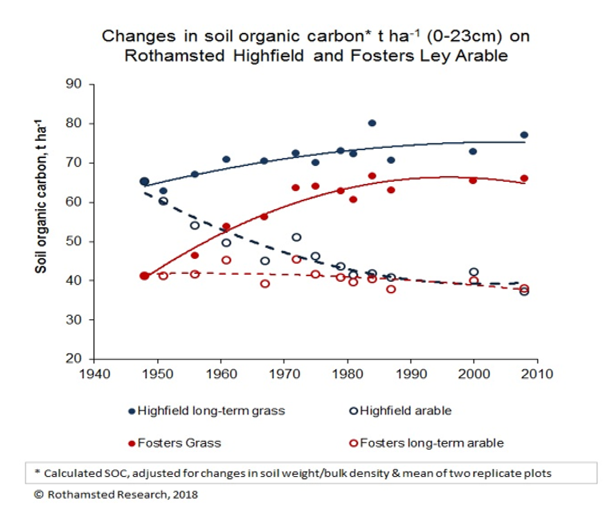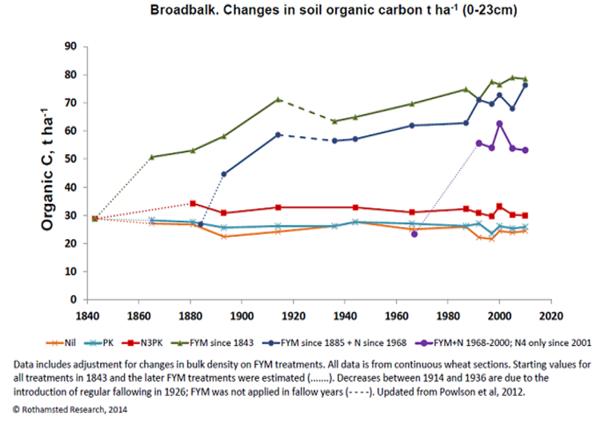Claim
There are only 100 harvests left in British soils.
What the science says
Incorrect.
Deteriorating soil health is one of the biggest challenges facing farming, today and in the future, but this claim misrepresents the study it was based on. Large areas of soil in the UK are considered to be degraded, and this is a very serious concern for farming as well as broader issues such as carbon storage. However, studies have not attempted to put a figure on the number of harvests or farmable years there are left in our fields.
From:
An article in the Independent claimed that British soils are so degraded that they will only be able to support 100 more harvests, and we are heading towards an agricultural crisis.
Based on:
A paper published in 2014 by University of Sheffield scientists, led by Dr Jill Edmondson, looked at the health of soils in and around Sheffield. It concluded that soil in city allotments was healthier than in surrounding arable fields. The paper says that the results demonstrates the extent to which modern agricultural practices have degraded soil, but they do not predict the remaining number of harvests a soil could support1.
The fuller picture:
There are many genuine statistics surrounding the important issue of soil health in the UK which are of concern. These include that erosion already affects around 17% of arable soils, and a further 40% are at risk of erosion, 40% are liable to compaction and that the costs of soil erosion run to £1.2 billion per year2. However, there have been no scientific estimates of the number of further harvests our soil can support.
Other claims have also been made, for example Michael Gove recently suggested that the UK is 30-40 years from losing its soil fertility. A speech at the UN’s Food and Agriculture convention suggested there are only 60 years of harvests in our soils. These numbers also appear to be unfounded.
However, poor soil health is thought to be a major factor limiting crop yield over the past decade or so3. Good soil health is a combination of favourable structure, a good level of organic matter and a healthy ecosystem of living organisms. As well as soil being lost though erosion, growing crops in compacted soils limits their ability to root effectively to take up nutrients and water4,5. In winter, poor quality soils are more prone to waterlogging, and crops on them are more susceptible to pests and competition from some weeds6.
Continuous farming can reduce the level of organic matter in soils, if it is not replaced, and this is thought to be limiting yields on UK farmland in recent years. However, the proportion of organic matter in farmed soils do not continue to fall to zero, they drop to a low level and then plateau there with continued farming7.

One particular example of deteriorating soil health is the widespread drainage and degradation of large areas of peat soils, upon which much agricultural production in the UK is reliant8. Draining these peatlands exposes the peat to the air, rendering it farmable, but also leading to peat shrinkage and erosion9. This process has led to the loss of sometimes metres of peat, for example from the areas of the Fens where the land surface has dropped (see picture), which if this process continues will lead to complete loss of the peat layer.
The importance of the living components of soils, such as earthworms and soil microbes, is also becoming better understood. Healthy soils are among the most diverse habitats on earth, with billions of individuals and up to a million species of bacteria alone living in each gram10,11. These microbes are involved in the provisioning and recycling of nutrients, for example certain bacteria fix nitrogen from the air and make it available for plants to use. Their role in nutrient cycling can mean they have a great impact on the diversity and productivity of plants12. Earthworms are also a good indicator of, and contribute to the maintenance of, healthy soils – eating organic matter and minerals and making compost which enriches the soil. In farming systems with moderate fertilizer use, where earthworms are present, yields are up to 25% higher than in areas where they aren’t13. Earthworm tunnels also help fields absorb water four to ten times faster than fields without tunnels, helping to buffer against flooding14. Monitoring earthworms and soil bacteria may help give an indication of overall soil health.
The effect of farming practice:
Traditionally, crop rotations and leaving land fallow were the approaches that maintained soil health, with what were called “exploitative” phases, when crops were grown, and “restorative” phases when the soil was allowed to recover. Modern methods have been developed that do not need these cycles – fertilisers and other treatments can replace the necessary nutrients, giving high yields in the medium term without these rest periods.

However, research suggests that this can lead to a fall in soil quality in the long term with continuous farming15. Increasingly it is thought that, for food production to be sustainable in the long term, we need to adjust agricultural techniques. For example, one possible approach is called Conservation Agriculture16, which includes reduced tillage, permanent ground cover including cover crops to protect soil structure, and crop rotation.
A very long-term experiment at the Sustainable Agriculture Science Department of the Rothamsted Research centre has been running since 1843. This looks at the yields and quality of winter wheat over that time, grown with different techniques and different inputs to study their effects. As a well-established, well-run experiment extending for over 150 years, there are a multitude of findings4, but some to note here are:
- Some plots have grown winter wheat continuously for the duration of the experiment, with no fertilizer added, and yields have remained low (1-2 tonnes per hectare) but stable4. Organic matter on these plots is also low but stable15.
- The addition of fertilizer in the form of farmyard manure or chemical fertilizers increases the available nutrients on those plots, and therefore their yields (~3t/ha before modern varieties, herbicides and fungicides, ~5-6t/ha since their introduction)4.
- Yields for winter wheat are highest the first year after a two-year break from cereals or grasses which are susceptible to the fungal disease known as take-all. Rotations which include two years of non-susceptible crops, followed by wheat, can give wheat yields that are twice as high (8-11t/ha)4.
- Particularly for barley, higher yields are obtained on plots which have higher organic matter in the soil – which can be achieved by fertilizing with manure instead of chemical additions, perhaps in conjunction with nitrogen4.
References and resources
1. Edmondson, J.L., Davies, Z.G., Gaston, K.J. & Leake, J.R. (2014). Urban cultivation in allotments maintains soil qualities adversely affected by conventional agriculture. Journal of Applied Ecology, 51:880–889.
2. Graves, A.R., Morris, J., Deeks, L.K., Rickson, R.J., Kibblewhite, M.G., Harris, J.A., Farewell, T.S. & Truckle, I. (2015). The total costs of soil degradation in England and Wales. Ecological Economics, 119:399–413.
3. Knight, S., Kightley, S., Bingham, I., Hoad, S., Lang, B., Philpott, H., Stobart, R., Thomas, J., Barnes, A. & Ball, B. (2012). Desk study to evaluate contributory causes of the current ‘yield plateau’ in wheat and oilseed rape.
4. Johnston, A.E. & Poulton, P.R. (2018). The importance of long-term experiments in agriculture: their management to ensure continued crop production and soil fertility; the Rothamsted experience. European Journal of Soil Science, 69:113–125.
5. Reddy, P.P. (2016). Agricultural Soil Compaction. In: Sustainable Intensification of Crop Production: 41–52. Springer Singapore. Singapore. doi:10.1007/978-981-10-2702-4_3
6. Hakenssonn, S. (2003). Weeds and weed management on arable land: an ecological approach. CABI Publishing. Oxford, UK.
7. Martyn, T. (2018). Grass leys in arable rotations. ADAS: Available at: https://www.adas.uk/News/grass-leys-in-arable-rotations.
8. Dawson, Q., Kechavarzi, C., Leeds-Harrison, P.B. & Burton, R.G.O. (2010). Subsidence and degradation of agricultural peatlands in the Fenlands of Norfolk, UK. Geoderma, 154:181–187.
9. Zeitz, J. & Velty, S. (2002). Soil properties of drained and rewetted fen soils. Journal of Plant Nutrition and Soil Science, 165:618–626.
10. Bender, S.F., Wagg, C. & van der Heijden, M.G.A. (2016). An Underground Revolution: Biodiversity and Soil Ecological Engineering for Agricultural Sustainability. Trends in Ecology and Evolution: 31:440–452.
11. Gans, J., Wolinsky, M. & Dunbar, J. (2005). Microbiology: Computational improvements reveal great bacterial diversity and high toxicity in soil. Science, 309:1387–1390.
12. Van Der Heijden, M.G.A., Bardgett, R.D. & Van Straalen, N.M. (2008). The unseen majority: Soil microbes as drivers of plant diversity and productivity in terrestrial ecosystems. Ecology Letters: 11:296–310.
13. Van Groenigen, J.W., Lubbers, I.M., Vos, H.M.J., Brown, G.G., De Deyn, G.B. & Van Groenigen, K.J. (2014). Earthworms increase plant production: a meta-analysis. Scientific Reports, 4:6365.
14. Peijnenberg, W. & Vijver, M. (2009). Earthworms and their use in eco(toxicological)modelling. In: Ecotoxicology modelling: (ed. Devillers, J.) Springer. New York.
15. Powlson, D.S., Bhogal, A., Chambers, B.J., Coleman, K., Macdonald, A.J., Goulding, K.W.T. & Whitmore, A.P. (2012). The potential to increase soil carbon stocks through reduced tillage or organic material additions in England and Wales: A case study. Agriculture, Ecosystems and Environment, 146:23–33.
16. Jones, C., Basch, G., Baylis, A., Bazzoni, D., Biggs, J., Bradbury, R., Chaney, K., Deeks, L., Field, R., Gomez, J., Jones, R., Jordan, V., Lane, M., Leake, A., Livermore, M., Owens, P., Ritz, K., Sturny, W. & Thomas, F. (2006). Conservation Agriculture in Europe: An approach to sustainable crop production by protecting soil and water?
https://www.scientificamerican.com/article/only-60-years-of-farming-left-if-soil-degradation-continues/
https://www.theguardian.com/environment/2017/oct/24/uk-30-40-years-away-eradication-soil-fertility-warns-michael-gove
https://www.newscientist.com/article/mg24232291-100-the-idea-that-there-are-only-100-harvests-left-is-just-a-fantasy/